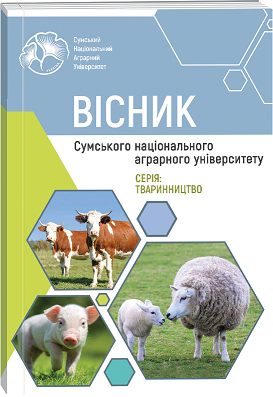Fattening and slaughter qualities of pigs of different weight categories grown up in pens on a polymeric and concrete floor
Abstract
The fattening and slaughter qualities of pigs of various weight categories (100; 110 and 120 kg), grown in pens on polymer and concrete floors, were studied. The experimental animals were placed in premises for growing up according to the same type of microclimate control system, in pens of the same design on a partially slotted floor at the rate of 0.32 m2 per head. The piglets of the control group were kept in a pen on a partially slotted polymer floor, and their analogs of the research group were carried out in a pen on a partially slotted concrete floor with a slot size of 15 mm. Ventilation in both rooms was negative pressure and maintained automatically. Heating was carried out using water heating built into the solid part of the floor. The resting place for piglets was 0.15 m2 per head. According to the research results, it was found that the potential for fattening productivity, caused by better conditions during the rearing period, was leveled with an increase in the slaughter weight. The living conditions during the rearing of piglets influenced the implementation of their fattening indicators, both with live weights of 100, 110, and 120 kg. With an increase in the pre-slaughter live weight, the influence of the conditions of keeping piglets on growing up decreased. Studies have shown that the conditions for rearing piglets in pens with the replacement of a part of the floor from polymer to concrete had a negative impact on the realization of the potential of meat productivity. A tendency was established for the deterioration of all slaughter qualities in pigs, which were raised in pens using a slatted concrete floor, and a significant decrease in the weight of the rear third of the half carcass was revealed by 3.6-7.5% at the slaughter of all studied weight conditions. Pig carcasses kept in stalls with a slatted polymer floor were found to have a higher meat content and less fat than analogs that were grown on a concrete slatted floor. With an increase in the pre-slaughter live weight of pigs of both types of maintenance, the content of meat and bones in their carcasses decreased and the content of fat increased.
References
2. Berezovskiy, N. D., Getya, A. A. and Vashchenko, P. A. 2007. Selektsionnaya rabota s krupnoy beloy porodoy sviney v Ukraine [Selection work with a large white breed of pigs in Ukraine]. Modern problems of intensification of pig production, Proceedings of the International Conference, Ulyanovsk, vol. 1, pp. 29-33.
3. Birta, G. A., Burgu, Yu. G. and Motornyy, Yu. V., 2008. Myasnye kachestva sviney raznykh genotipov v zavisimosti ot vliyaniya na nikh paratipicheskikh faktorov [Meat qualities of pigs of different genotypes, depending on the influence of paratyp-ical factors on them]. Visnik Poltavs'koї derzhavnoї agrarnoї академії, no. 4, pp. 106-110.
4. Erikson, D. 2015. Amerykanska tekhnolohiia utrymannia svynei (vid vidluchennia do zaboiu) [American technology of keeping pigs (from weaning to slaughter)]. Prybutkove svynarstvo, no. 3(27), pp. 64-67.
5. Koval, O. A. and Kalynychenko, H. I., 2012. Efektyvnist vyroshchuvannia remontnoho molodniaku svynei na re-shitchastii pidlozi [Efficiency of raising replacement pigs on a slatted floor]. Zbirnyk naukovykh prats Vinnytskoho natsionalnoho ahrarnoho universytetu. Seriia: Silskohospodarski nauky, issue 5(67), pp. 124-125.
6. Lykhach, V., 2015. Tekhnolohichni osoblyvosti vyroshchuvannia porosiat [Technological features of growing piglets]. Tvarynnytstvo Ukrainy, no. 6, pp. 11-13.
7. Merkur'eva, E. K., 1977. Geneticheskie osnovy selektsii v skotovodstve [Genetic principles of selective breeding in cattle breeding]. M.: Kolos.
8. Koba, V. H., [et al.], 2000. Mekhanyzatsyia y tekhnolohyia proyzvodstva produktsyy zhyvotnovodstva [Mechanization and technology for the production of animal husbandry products]. M.: Kolos.
9. Povod, M. H. and Shpetnyi, M. B., 2016. Sezonna produktyvnist porosiat na doroshchuvanni u stankakh za riznoho rozmiru hrup ta typu pidlohy [Seasonal productivity piglets on growing in stalls of different size of groups and the type of floor]. Naukovo-tekhnichnyi biuleten IT NAAN, no. 116, pp. 126-134.
10. Reshetnyk, A. O., Smoliak, V. V. and Laiter-Moskaliuk, S. V., 2016. Stan dobrobutu svynei u promyslovomu svynarstvi [The welfare state of pigs in industrial pig production]. Naukovyi visnyk LNUVMBT im. S. Z. Gzhytskoho, vol. 18, no. (72), pp. 66-71.
11. Rybalko, V. P., Berezovskyi, M. D., Bohdanov, H. A. [et al.], 2005. Suchasni metodyky doslidzhen u svynarstvi [Modern research methods in pig breeding]. Poltava: Instytut svynarstva im. O.V.Kvasnytskoho UAAN.
12. Sadomov, N. A., 2015. Energiya rosta porosyat na dorashchivanii v zavisimosti ot sposoba soderzhaniya [Growth energy of piglets on growing, depending on the method of keeping]. Actual problems of intensive development of animal hus-bandry, Proceedings of the XVIII International Conference dedicated to the 85th anniversary of the zooengineering faculty and the 175th anniversary of the educational establishment "Belarusian State Agricultural Academy" (Gorki, May 28-29, 2015), pp. 163-166.
13. Chernyy, N. V., Onokienko, N. I. and Momot, L. N., 2006. Vliyanie polov na zdorov'e sviney [Influence of slatted floor on pig health]. Ways to intensify the pig industry in the CIS countries, Proceedings of the XIII International Conference. Zhodino, pp. 162-163.

 ISSN
ISSN  ISSN
ISSN 


